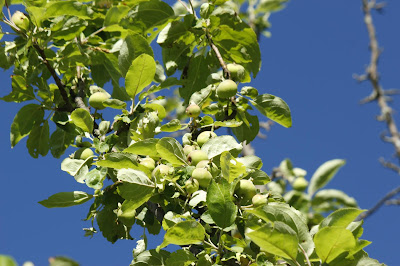“It’s no ordinary apple tart. It’s the apple tart of hope. After you’ve taken a bite, the whole world will look almost completely different. Things will start to change and by the time you’ve had the whole slice, you’ll realize everything is going to be okay.” Sarah M. Fitzgerald
 |
| The Tart Apple of Hope |
Bring on the apple tarts, sunshine, and walks in the woods. This recipe is easy for families to make and a keeper for the recipe folder. You can make your own crust or use a store bought crust. The secrets are the apples and the apricot drizzle.
Tart Recipe
You will need four large Granny Smith apples, ½ cup sugar, 4 Tablespoons (1/2 stick) cold butter, small diced, ½ cup warmed apricot jelly or strained apricot jam and 2 Tablespoons water. Preheat the oven to 400 degrees and line a large tart pan, cookie sheet, or pie pan with parchment paper.
 |
| Family Baking is Fun & Tasty! |
You will need a raised edging so the juice from the apples does not over flow and burn. If you are using cookie sheet, the dough should be like an open pouch around the apples. You can layer the parchment, a piece of tin foil and then the open pouch crust. No matter what base you are using, place the prepared pan or sheet in the refrigerator while preparing the apples.
Adults or teens can peel the apples and cut them in half through the stem. Remove the stems and cores with a knife and a melon baller. Slice the apples crosswise in ¼-inch-thick slices. Place overlapping slices of apples diagonally down the middle of the tart and continue making diagonal rows on both sides of the first row until the pastry is covered with apple slices. Some people make concentric circles. Sprinkle with the full ½ cup sugar and dot all over with the butter. Allow the children to help with everything possible.
 |
| All Hands Make this Cooking Project a Success! |
Baking
Bake for 45 minutes to 1 hour, until the pastry is browned and the edges of the apples start to brown. Rotate the pan once during cooking. If the pastry puffs up in one area, cut a little slit with a knife to let the air out. Place strips of two -inch wide foil on the edges of the pie pan crust to keep the edges from getting too brown.
When the tart’s done, heat the apricot jelly together with the water and brush the apples the pastry completely with the jelly mixture. Some people drizzle the apricot mixture toward the end of baking. Loosen tart with a metal spatula and allow to cool. You may add whipped cream or vanilla ice cream.
More Ideas and Activities....See the authors’ book “Learning Through the Seasons” at area bookstores and grandparentsteachtoo.org. For more help to prepare young children for success in school see the authors’ web site: www.grandparentsteachtoo.org. Also check our audio Podcasts WNMU Radio 90; Youtube video activities; and join us on Pinterest
Photos: Fran Darling, fdarling fotos
Sketches: Mark Nowicki




